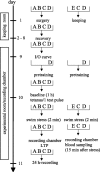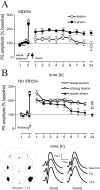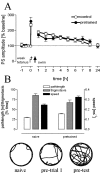Bidirectional modulation of hippocampal long-term potentiation under stress and no-stress conditions in basolateral amygdala-lesioned and intact rats
- PMID: 16093390
- PMCID: PMC6725292
- DOI: 10.1523/JNEUROSCI.0910-05.2005
Bidirectional modulation of hippocampal long-term potentiation under stress and no-stress conditions in basolateral amygdala-lesioned and intact rats
Abstract
Hippocampal long-term potentiation (LTP) is widely considered as a cellular model for learning and memory formation. We have shown previously that protein synthesis-independent, early dentate gyrus (DG) LTP, lasting approximately 4-5 h, can be transformed into a late-LTP with a duration of > or = 24 h by a brief acute swim stress experience (high-stress condition). This reinforcement requires the activation of mineralocorticoid receptors and protein synthesis. The basolateral amygdala (BLA) is known to modulate glucocorticoid effects on the consolidation of spatial/contextual memory via a beta-adrenergic mechanism. Interestingly, hippocampal DG-LTP can also be indirectly modulated by beta-adrenergic and cholinergic/muscarinergic processes. Here, we show that the reinforcement of early-DG-LTP under high-stress conditions depends on the processing of novel spatial/contextual information. Furthermore, this reinforcement was blocked in BLA-lesioned animals compared with sham-operated and intact controls; however, it was not dependent on beta-adrenergic or cholinergic/muscarinergic receptor activation. In contrast, under low-stress conditions, the induction of late-LTP in BLA-lesioned animals is facilitated, and this facilitation, again, was dependent on beta-adrenergic activation. The data suggest that DG-LTP maintenance can be influenced by the BLA through different mechanisms: a short-lasting corticosterone-dependent and beta-adrenergic-independent mechanism and a long-lasting mechanism that facilitated hippocampal beta-adrenergic mechanisms.
Figures






Similar articles
-
Glucocorticoid receptors and beta-adrenoceptors in basolateral amygdala modulate synaptic plasticity in hippocampal dentate gyrus, but not in area CA1.Neuropharmacology. 2007 Jan;52(1):244-52. doi: 10.1016/j.neuropharm.2006.07.007. Epub 2006 Aug 7. Neuropharmacology. 2007. PMID: 16890964
-
Reinforcement of early long-term potentiation (early-LTP) in dentate gyrus by stimulation of the basolateral amygdala: heterosynaptic induction mechanisms of late-LTP.J Neurosci. 2001 May 15;21(10):3697-703. doi: 10.1523/JNEUROSCI.21-10-03697.2001. J Neurosci. 2001. PMID: 11331399 Free PMC article.
-
Modulation of late phases of long-term potentiation in rat dentate gyrus by stimulation of the medial septum.Neuroscience. 2003;118(4):1055-62. doi: 10.1016/s0306-4522(03)00029-0. Neuroscience. 2003. PMID: 12732250
-
Modulation of hippocampal long-term potentiation by the amygdala: a synaptic mechanism linking emotion and memory.Jpn J Pharmacol. 2001 May;86(1):18-22. doi: 10.1254/jjp.86.18. Jpn J Pharmacol. 2001. PMID: 11430468 Review.
-
Stress modulation of hippocampal activity--spotlight on the dentate gyrus.Neurobiol Learn Mem. 2014 Jul;112:53-60. doi: 10.1016/j.nlm.2014.04.008. Epub 2014 Apr 18. Neurobiol Learn Mem. 2014. PMID: 24747273 Review.
Cited by
-
The temporal dynamics model of emotional memory processing: a synthesis on the neurobiological basis of stress-induced amnesia, flashbulb and traumatic memories, and the Yerkes-Dodson law.Neural Plast. 2007;2007:60803. doi: 10.1155/2007/60803. Neural Plast. 2007. PMID: 17641736 Free PMC article. Review.
-
Visualizing BDNF Transcript Usage During Sound-Induced Memory Linked Plasticity.Front Mol Neurosci. 2018 Jul 31;11:260. doi: 10.3389/fnmol.2018.00260. eCollection 2018. Front Mol Neurosci. 2018. PMID: 30127717 Free PMC article.
-
Acute stress impairs hippocampal mossy fiber-CA3 long-term potentiation by enhancing cAMP-specific phosphodiesterase 4 activity.Neuropsychopharmacology. 2010 Jun;35(7):1605-17. doi: 10.1038/npp.2010.33. Epub 2010 Mar 17. Neuropsychopharmacology. 2010. PMID: 20237461 Free PMC article.
-
Acupuncture Prevents the Impairment of Hippocampal LTP Through β1-AR in Vascular Dementia Rats.Mol Neurobiol. 2018 Oct;55(10):7677-7690. doi: 10.1007/s12035-018-0943-x. Epub 2018 Feb 13. Mol Neurobiol. 2018. PMID: 29435917
-
The basolateral nucleus of the amygdala is necessary to induce the opposing effects of stressful experience on learning in males and females.J Neurosci. 2008 May 14;28(20):5290-4. doi: 10.1523/JNEUROSCI.1129-08.2008. J Neurosci. 2008. PMID: 18480285 Free PMC article.
References
-
- Abe K, Nakata A, Mizutani A, Saito H (1994) Facilitatory but nonessential role of the muscarinic cholinergic system in the generation of long-term potentiation of population spikes in the dentate gyrus in vivo. Neuropharmacology 33: 847-852. - PubMed
-
- Almaguer-Melian W, Martinez-Marti L, Frey JU, Bergado JA (2003) The amygdala is part of the behavioural reinforcement system modulating long-term potentiation in rat hippocampus. Neuroscience 119: 319-322. - PubMed
-
- Bergado JA, Almaguer-Melian W, Kostenko S, Frey S, Frey JU (2003) Behavioral reinforcement of long-term potentiation in rat dentate gyrus in vivo is protein synthesis-dependent. Neurosci Lett 351: 56-58. - PubMed
Publication types
MeSH terms
Substances
LinkOut - more resources
Full Text Sources
Medical
